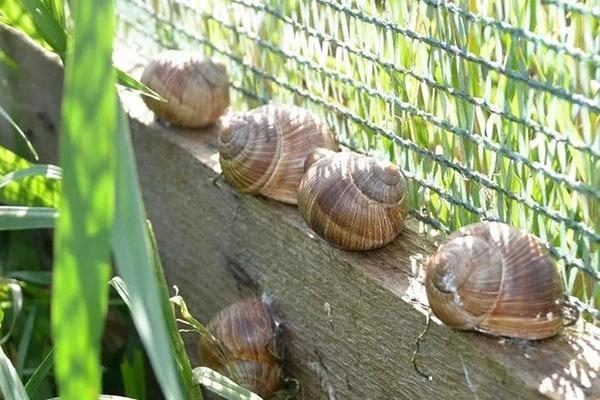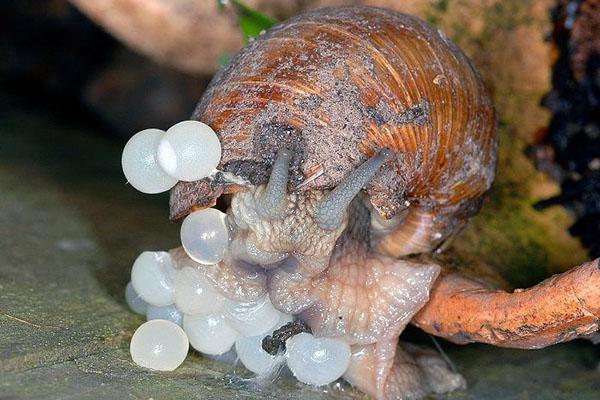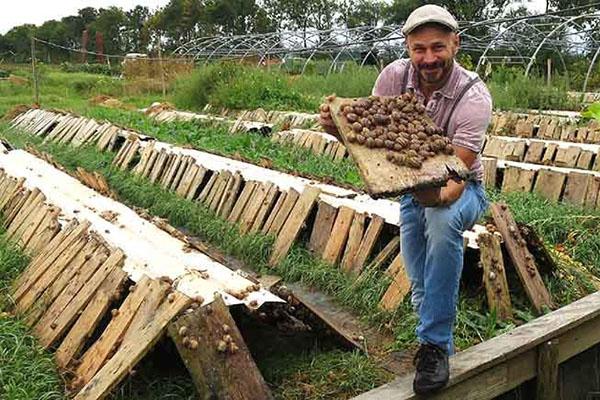Breeding grape snails is a profitable business for the lazy

A profitable business of the 21st century is the cultivation of grape snails at home. Often small households or individual farmers are involved in this business. This exotic product is well paid both in Europe and in Russia. Restaurants, pharmaceutical companies, and other food businesses can become regular customers of shellfish. For business to go well, it is important to learn some of the intricacies of breeding, growing and keeping snails.

Business profitability - 100%. The offspring of one individual per season is 50 large snails, that is, about 20 kg of snail meat. The cost (purchase) of an exotic product on the world market is $ 5 / kg, and caviar is $ 200/100 g.
Breeding grape snails: from paper questions to farm work

Starting a business begins with the registration of a private entrepreneur, as well as obtaining permits from the SanEpidemStation and the fire department. To sell a food product, you will also need a quality certificate from veterinary government services. After completing legal issues, proceed to the purchase of material.
It is important to know that:
- the approximate price of one adult mollusk in Europe is $ 4, and in Russia - 30 rubles;
- for a small farm, you will need 300-400 individuals;
- the total cost of such a broodstock can be about $ 1,600 or 12 thousand rubles.

Germany, Poland, Tunisia and the Czech Republic supply grape snails to the whole world. However, you should buy products only from trusted suppliers. Financial issues also include the amount and cost of feed. During the season, this "exotic herd" consumes up to 20-25 kg of feed mixture, the average cost of which varies from 300-500 rubles / kg. In addition, the final result is influenced by the conditions of detention and the characteristics of the reproduction of grape snails at home.

The last point is significant, even though they are hermaphrodites. This special period begins in March and ends in May. During these months, they are placed in pairs in boxes. The eggs laid by them are sent to incubators. Young animals are relocated to an adult herd only after 6 months.
Keeping grape snails is not a royal mansion, but decent apartments

The premises are selected for their original nursery with a good ventilation system. The air humidity in it should not be lower than 85%. Any temperature fluctuation in the cultivation of grape snails is not permissible. The thermometer should not fall below 20˚С and rise above 23˚С. Such a stable microclimate contributes to their rapid reproduction and growth.
They are grown in 3 ways:
- placing in glass or plastic terrariums with soil / sand;
- in greenhouses, garages, basements or covered areas;
- in open air pens.
It is necessary to monitor the cleanliness of the premises, terrariums. The soil boxes are cleaned of mucous residues every 3 days to avoid the formation of a breeding ground for harmful bacteria.

The size of the plot should be suitable, as it is not always easy to care for the snail. For every 30-40 individuals, you will need up to 1 m² of free space. A garage or room is selected with an area of 20 m², and an outdoor farm - 50 m².
Some experienced farmers have made their own calculations for breeding snails in greenhouses:
- For a broodstock of 750 individuals, a 4 m² room is selected.
- Adult uterine snails are kept in 8 plastic containers (dimensions 100x50 cm).
- As incubators for the maturation of eggs, select a room up to 18 m².
- Youngsters are grown in plastic cuvettes (150 pcs.).
- The main herd is housed in a fenced-in aviary (according to some estimates, its area may be 400 m²).

The soil mixture must be fertilized with calcium and other mineral components so that the mollusks develop under normal conditions. In open areas, the farmer will have to protect his herd from pests and rodents. This is one of the disadvantages of open methods for keeping grape snails. Moreover, it is only suitable for southern regions with a humid climate.
Like all living things, snails can hibernate when the air temperature drops. Therefore, the microclimate in the room is kept warm using heating systems.
The diet of grape snails is a common meal for unusual "persons"

The name of these molluscs indicates which food they prefer the most. For this reason, many farmers choose an area with wild grapes or succulent weeds for their cultivation. The height of the green mass in such areas should not exceed 10 cm. But it is better to organize additional food for them. For this, it is important to know what grape snails eat.

Basically, their diet consists of:
- fresh herbs (weeds, cabbage, dandelions, sorrel);
- berries: raspberries, strawberries and other fruits and vegetables;
- fallen leaves;
- compound feed;
- a specially prepared feed mixture: crushed cereals, grass, as well as a mineral additive in the form of chalk;
- powdered milk.
There is no need to stop only on artificial nutrition. The meat of an exotic product acquires a refined taste if the diet of snails contains a lot of juicy greens.
From time to time they buy special food. It contains unique ingredients that help molluscs become fleshy and large. However, the size of individuals largely depends on how much the grape snails grow. Some of them gain full weight after 6 months, while others only after 1.5 years. Adults are about 5 cm long.
Continuation of the case

Once the young have reached their optimal growth point (after 6-9 months), they can be removed from the shell. In order for the body of the mollusk to be completely cleansed, it is not fed or watered for 3-4 days.
Harvesting an unusual crop is carried out:
- weekly;
- in spring or autumn;
- in rainy weather;
- using slate sheets or other surfaces.

Some experts advise sending the harvested snails to special cages for 7 days, where they will cleanse their digestive system of soil residues. Only then can they be killed. The next stage in the preparation of semi-finished products is their instant freezing. Such a product should be sold as soon as possible.

Some customers prefer to purchase live individuals. Therefore, they are placed in a special container with ventilation holes. However, they should not be stored with dead shellfish.
Before the delicacy is sold, experienced farmers select the largest specimens for further breeding. Understanding how long grape snails live (7-8 years), a fertile broodstock is kept for 3 years.
During this time, the businessman finds regular customers, which can be:
- elite restaurants;
- catering establishments;
- cosmetology firms;
- enterprises preserving delicacies, as well as shellfish caviar;
- pharmaceutical companies.
Additional information about these companies will help you find your client. The breeder needs to investigate if the restaurant's menu has such an exotic product. In other cases, it is important to find out if the factory is engaged in the production of these delicacies. Then there is little to do: contact the supply department and negotiate the terms of the contract.

Estimated financial statement.The purchase of equipment and rental of premises will require up to 10 thousand rubles for each expense item. To rent a land plot, you need to invest 20 thousand. Broodstock (750 pcs.) Will cost 5,000 rubles, and 20 thousand rubles will be spent on feed. The start-up capital will be 45-85 thousand rubles, and the monthly income will be 20,000 rubles.
Nature's Tips for Gourmets: Wintering and Grape Snail Habitat

Some do not breed, but collect shellfish for their culinary masterpieces. Therefore, they do not need to invest in this business. It is enough just to know the habitat of grape snails. They come from Southeast and Central Europe. In the wild, mollusks live at an altitude of 2 thousand meters above sea level.
However, you can find them in ordinary places:
- in the park area;
- on flattering edges;
- among overgrown bushes;
- in valleys and meadows;
- in vineyards;
- on alkaline, limestone soils.
Sometimes they hide in shady thickets or under large boulders / rocks. In some cases, individuals burrow into wet moss, from which coolness blows. To find them in the spring, you need to find out where grape snails winter in nature. According to the study, with the help of their fleshy body, they burrow into the ground and fall into a state of suspended animation at a depth of 30 cm. These shelters are their permanent wintering grounds. In order not to freeze, they close the hole of the sink with a limestone plug.

As you can see, breeding grape snails is a fun, profitable and fairly simple activity. To do this, you only need to prepare a spacious room with a humidity of 85% and plan a proper diet. In addition, it is necessary to regularly clean the area from mucus to protect "pets" from bacteria. Observing these requirements for their cultivation, in 6-18 months you can get a rich offspring of snails.
Snails, this is erez-chur exotic, I have myriads of snails on my site, but they are very small! Farming is closer to me. I would like to know about the intricacies, especially - about slaughter and marketing. What documents and authorities need to be collected and bypassed?